Both teams arrived at this match with great expectations. For Italy, having not qualified for 12 years for the FIFA Women’s World Cup, this match was of great significance. After topping their group, there was a lot of pressure on Le Azzure to go even further. On the other hand, China looked for a chance to regain their former glory. Having come third in their group, China wanted redemption and this match gave them an opportunity to do that. In this tactical analysis, we will show you an analysis of the tactics that made one team win and the other one lose.
Teamsheet
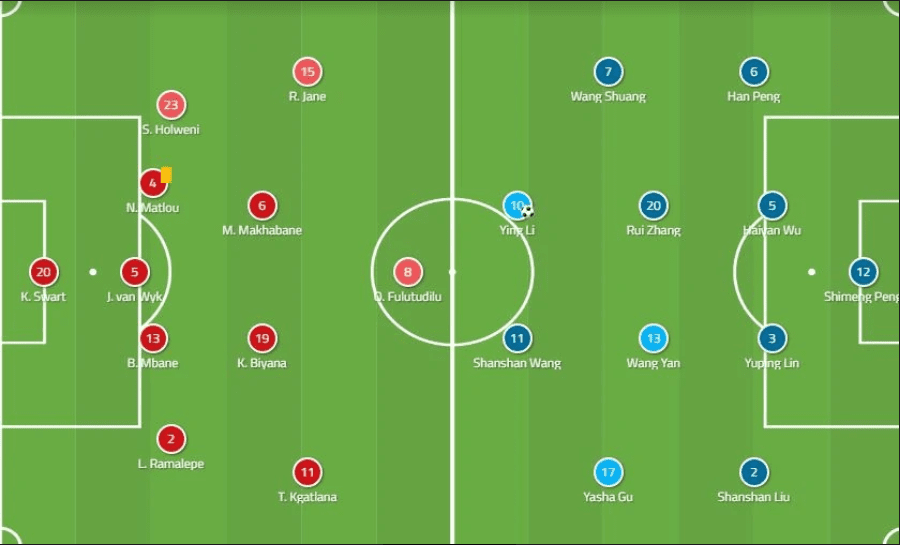
Jia Xiuquan made no changes to the team personnel and formation that had drawn 0-0 against Spain. On the other hand, Milena Bertolini made one change to the team that lost 1-0 to Brazil. Aurora Galli was replaced by Valentina Bergamaschi. Additionally, Bertolini switched Italy’s formation from a 4-3-1-2 to a 4-2-3-1.
Italy’s intricacies in buildup cripple China
While on paper, China lined up in a 4-4-2, they were actually liable to switch their possession in various parts of the game.
One such part of the game where China switched their formation was when Italy was initiating their buildup. China would transform from a 4-4-2 to a 4-3-1-2, with one of the forwards, usually Shuang Wang, dropping between the forward and the midfield line.
The idea behind China’s pressing pattern against Italy made logical sense. Whenever Italy initiated their buildup, they did so in textbook fashion. The four-man backline split with the full-backs positioning themselves near the wing.
In addition, the centre-backs would split up so that the distance between them was considerably large. Moreover, out of Italy’s midfield pivot, one of the midfielders would drop in deep. This midfielder performed the role of a regista, progressing the ball from the defensive line to the midfield or attack line.

As one can see here, the holding midfielder links up the two centre-backs, shown in blue, and full-backs, shown in red. Additionally, the width between the centre-backs means that the holding midfielder has enough space to drop into and start springing passes forward.
As such, by China’s standards, it makes perfect sense to drop one of their forwards between the midfield and attack line. This forward can man mark the regista and potentially dispossess the holding midfielder.
However, this attempt to control the holding midfielder meant that China became narrow when confronting Italy’s buildup. This narrow pressing pattern by China would become one of their weaknesses in the entire game.
Shuang would drop deep between China’s two lines and as such, China’s midfield was not as close to the forwards. Moreover, the presence of only two forwards meant that the halfspace was free. This allowed Italy to get past the man-marking of their holding midfielder.
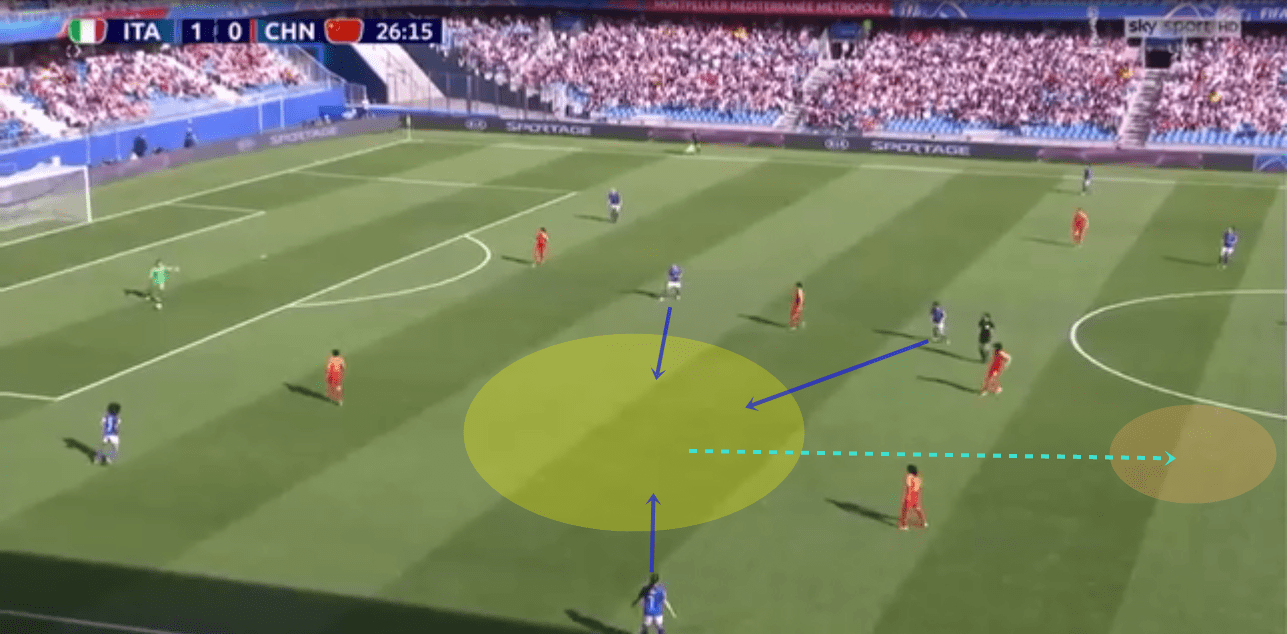
Here in the picture above, we can see that almost three Italian players can come and control the halfspace. From there, these players can play a vertical ball to a player higher up the said halfspace. As such, this space allows Italy to progress the ball forward in an instant.
The narrow buildup pattern also led to some more intricacies that allowed Italy to succeed.
One such intricacy involved numerical superiority throughout the midfield line. As discussed before, China pressed in a 4-3-1-2 pattern. When Italy started building, they initially had three players in the whole of the midfield line. This meant that there was a 3v3 in the centre of the pitch.
However, Italy employed a simple tactic that allowed them to hurt China more.
They simply dropped their one of their attackers into the centre of the pitch. This created a 4v3 in the centre of the pitch. From here, Italy deployed a simple tactic of a long ball.
Italy’s intention was not for their forwards to win the long ball immediately. Their hope was that they would lose the first aerial battle so that they could win the second ball. Having four players in the middle of the pitch allowed Italy to dominate China’s attempt at possessing the second ball.

As we can see in this picture, the forward is dropping into space (shown in yellow). This movement is critical as it allows Italy to have more men when the long ball to the forwards go through. Moreover, the attacker also situates himself between Chinese players which allows him to receive a vertical or diagonal pass from the defensive line.
From here, it would be a 4v4 as China’s backline would directly be combating Italy’s three attackers followed by Italy’s ball carrier. This gave Italy a direct counterattack after only one pass.
Another one of Italy’s intricacies in their build-up involved their insistence on keeping their ball in their half. In the usual buildup, the goal is to progress the ball upwards in a counter-attacking situation. Sometimes, teams are willing to wait in their own half or zones for some time.
However, in Italy’s case, whenever they got out of China’s forward pressing and got their ball to the full-back, the full-back would drop deep and give the ball to one of the centre-backs. While at first, this tactic seems counterintuitive to build-up, a closer look reveals Italy’s ingenious plan at work.
By dropping deep as soon a full-back got the ball, Italy eventually forced China to lose its shape and start pressing. With the whole team dropping back, China’s two forwards started doing a curved run which allowed them to defend against the centre-backs but also go straight at the ball holder.
Moreover, the midfield line broke loose since the full-back, inevitably, dragged a midfielder into Italy’s half. As such, whenever the ball was brought deep, China would end up engaging three to four players on the ball holder.
This type of build up left the rest of the Steel Roses ill-equipped in handling balls to the wide or central areas. Italy recognised this situation and sent long balls to their attackers.
Yet again, Italy’s intentions were not for the forwards to win the ball. The aim was to lose the first aerial duel and win the second ball. This would allow the nearby players to get the ball and directly attack the Chinese defence.
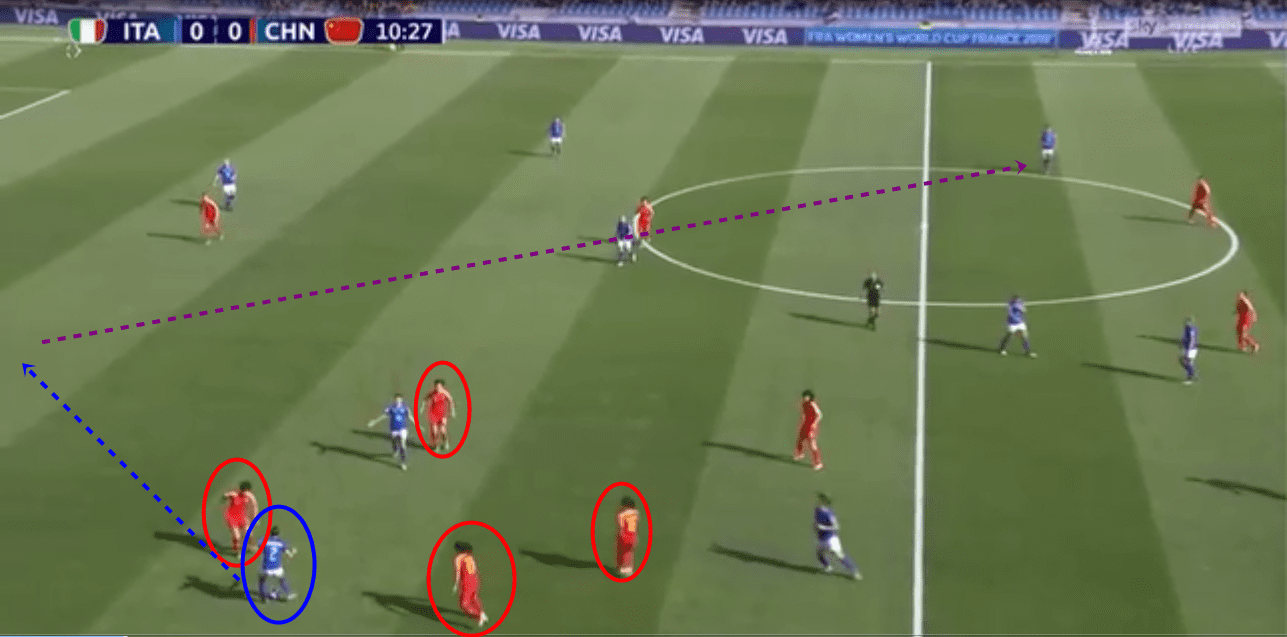
Here, the ball holder will pass to a nearby midfielder or to the centre-back. Note how from this situation, Italy have concentrated four of China’s players on one side. Now the centre-back can play a long ball to the Italian attacker on the left-hand side.
She is in a 1v1 situation and as such can directly attack the Chinese defence. Additionally, she can also link up with nearby Italian attackers and as such, they can win the second ball. This second ball will directly threaten the Chinese defence as there will be a 3v3 situation with Italy already in a dangerous position.
Italy’s effective man-marking weakens China’s buildup and possession
One of the visual, and tactical, components of this game was the intensity of the play. From the get-go, one team had much more energy compared to the other team.
The team with the energy turned out to be Italy. Right from the whistle, they were relentless in their pursuit of a goal. As such, whenever one of China’s players had the ball, one of Italy’s players would man-mark her.
However, Italy’s man marking was quite different. The man-marking was full of energy and as such, often times, only one person was required to dispossess China. Strong and clever in their challenges, Italy succeeded in dispossessing China in the midfield area quite a lot of times.
Sometimes when a single person was not enough, as was the case with the talented Wang, Italy would devote two of its players. Doubling the intensity on China’s players ended up paying dividends as China never looked comfortable on the ball.
Always wary of Italy’s aggressive pressing and intensity, China looked to recycle possession of the ball by playing horizontal passes. Yet as soon as a vertical or horizontal press, Italy would start becoming aggressive.
This intensity was also afforded to China’s buildup. Italy were looking to not give China a moment’s rest. While other teams in the WWC had generally waited to trigger the pressing on China’s build-up, Italy did not wait around.
As soon as China starting building out from the back, Italy’s strikers and the attacking trio were controlling the most important players for China’s buildup: midfielders and centre-backs. This forced China to make long balls.

As we can see here, five Italian players are man-marking some of the most important players for China. Both of the midfielders are restricted while two are covering a centre-back and full-back. This restricts China from building out as the presence of the midfield pivot is critical for China’s build-up plan. Additionally, by man marking the full-back and centre-back, Italy also restrict China from playing in certain directions. As such here, China has to resort to playing long balls.
In past matches, China used their long balls to great effect by having Shanshan Wang dropping deep and serving as a target man. However, in the match against Italy, Shanshan’s presence of dropping deep did not aid China as Italy enforced a man marking on her as well.
Any attempt from China to shake off Italy’s man-marking usually resulted in fouls that favoured Italy or simple frustration. Italy were fully concentrated and resolute in their pressing and positioning.
China’s lack of intensity allows Italy to relentlessly attack
Italy’s results from this pressing – dispossessions – was partly aided by China’s lack of intensity. While Italy were chasing down long balls and actively pressing their targets, the Steel Roses were looking lost.
With their build-up pattern disrupted and an aggressive marking system from Le Azzurre, China were not active on the ball. Too many times, their players would hold possession of the ball too long. This would result in an attraction of Italian players who would successfully dispossess China.
These dispossessions happened in the middle of the pitch but also in China’s defensive third which meant that Le Azzurre kept edging closer to China’s goal. The Steel Roses kept making stray or loose passes near their own goal and these passes yielded in countless Italian counterattacks.
China’s lack of intensity is evident in both of their goals. In the first goal, two centre-backs are near the wing flank with one of them having the ball. Le Azzurre’s striker, Valentina Giacinti presses the ball carrier and succeeds in dispossessing them.
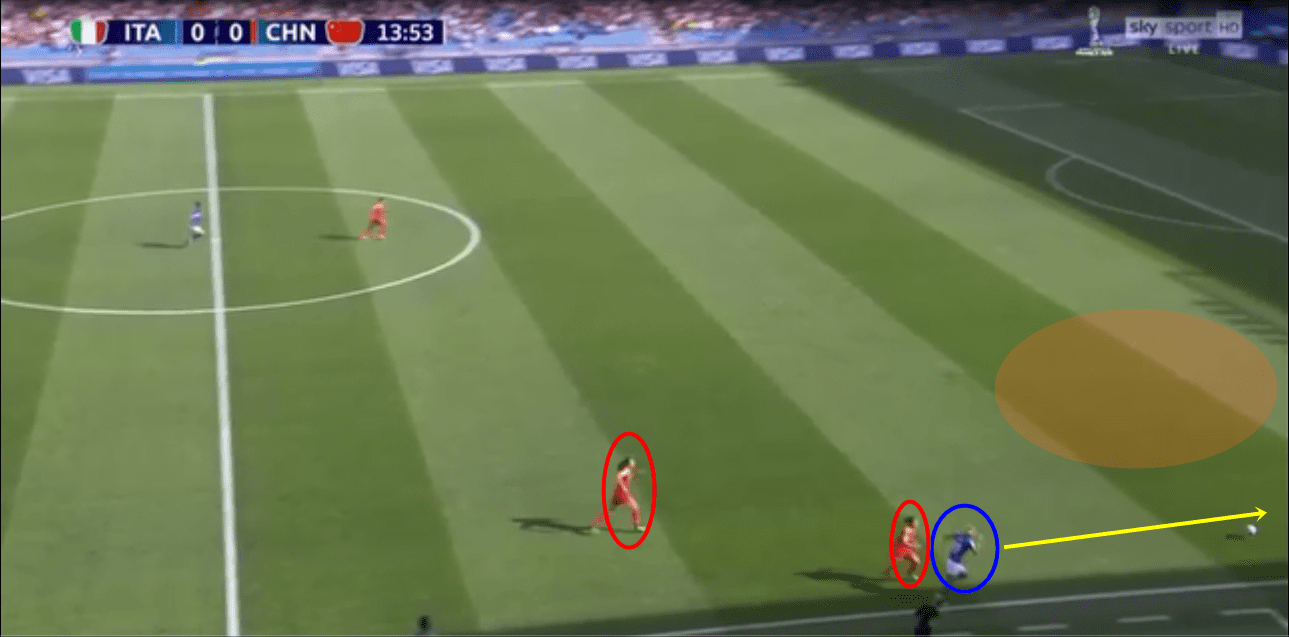
Here Giacinti has stolen the ball and can now attack the space directly behind the Chinese defence. This means even though China have numerical superiority, they cannot affect the outcome of Giacinti’s run as much. Note the Italian attacker on the other side and how she can make a curved run and make a tap in.
After her run, Giacinti stalls which allow China to three to four players back. However, this arrival is too disorganised which means that a rebound is not cleared by any of the Steel Roses’ defenders. This allows Giacinti to squeeze in and score the first goal.
The second goal starts with China being heavily pressed back near their goal. While still having possession, China attempt to play short passes and get past the Italian press. However, a stray pass results in Italy getting the ball in the halfspace.

In the picture above, the midfielder stalls for just the right amount of time. She attracts two midfielders and passes the ball to Galli who gets enough time to fire a shot and score the second goal. As we can see here, a lack of intensity has left Galli free. China should have a midfielder or another player covering the area that Galli inhabits.
China’s dying attempts at a goal
As the game went on, Italy’s aggressive pressing started to slowly die down. Now, the Steel Roses found themselves with a bit more time and space on the ball and as such, they were able to play some attacking movements.
Most of the attacking movement that happened occurred between the trio of Shuang, Shanshan, and Ying Li. Shuang, who was situated on the wing, often dropped in the central areas.
With less pressing, Shuang was finding herself defeating one to two Italian players and finding space to her left and right. Moreover, the movements of the two forwards, Shanshan and Ying, created some trouble in the Italian backline.
Shuang would often dribble inward while Shanshan and Ying would start drifting outwards. This would create a hole in the centre of the backline. As Italy flooded their players to fill the hole, Shuang would pass to the other side where China could create a 1v1.
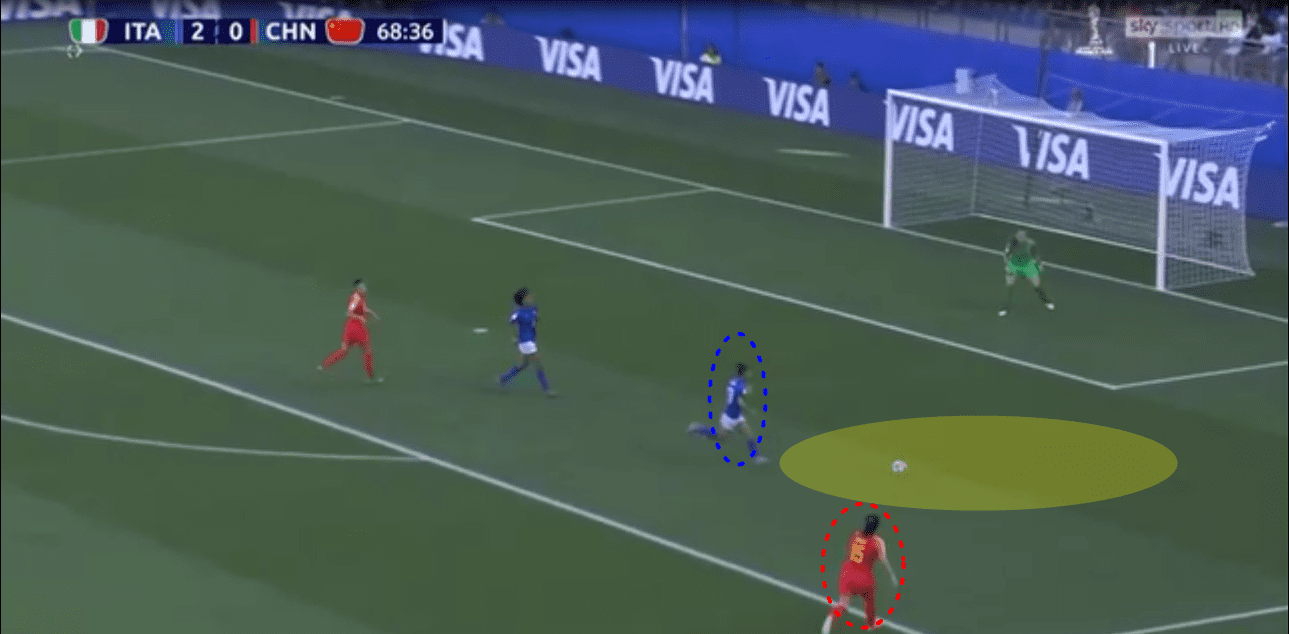
Here we Shuang’s excellent pass has released one of China’s players in a 1v1 position. If the player reaches the ball, she can make a dangerous cutback or a low cross to her fellow striker. If she doesn’t reach the ball and has to contest for the ball, there are chances that the ball might go behind the line and as such result in a corner kick. Either way, this pass has placed China in an attacking position.
Shuang would also create chipped balls to create a 1v1 for strikers Ying and Shanshan. However, poor communication and coordination often meant that the striker was often surrounded by a sea of blue. As such, the attack would fizzle out.
Conclusion
Italy, after 12 years of exile, have made their way into the quarterfinals. For such a team, it has been an amazing ride. From topping their group to defeating old heavyweights such as China, Le Azurre have come far. Bertolini will no doubt be impressed by her team. The team was proactive and aggressive in their desires for a goal. The hope will be to defeat the Netherlands and potentially advance even further.
For old heavyweights China, this loss will be undoubtedly a heavy blow for the Steel Roses. They lost their style and their composure in the match and Xiuquan will be asking key players like Ying and Shuang what went wrong. His biggest worry will be how his team lost their ability to stay calm, indicating that the Steel Roses are a shell of their once fiery attitude. With another turn of the day, another team bows out. As the best survive, this FIFA Women’s World Cup offers to be one of the best in recent history.
If you are following the FIFA Women’s World Cup 2019 then you will find our FREE tactical preview magazine the perfect compliment to the tournament. You can download it HERE – each nation is previewed and we also profile their key player and young player to watch. Enjoy!

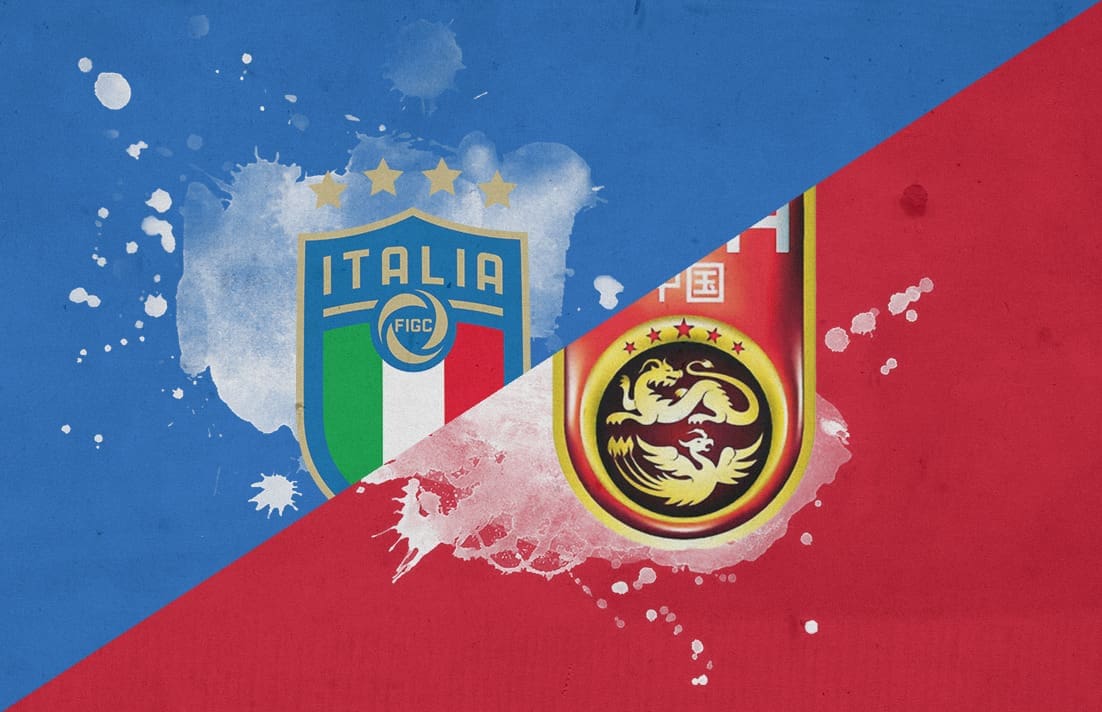



Comments